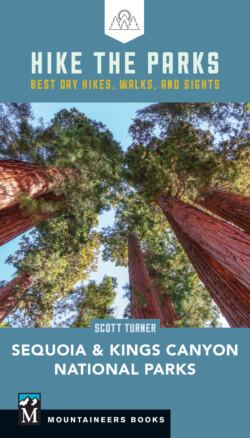Читать книгу Hike the Parks Sequoia-Kings Canyon National Parks - Scott Turner - Страница 20
На сайте Литреса книга снята с продажи.
FAUNA
ОглавлениеThe vast forests of the western Sierra Nevada shelter a wide array of wildlife, ranging from seldom-seen salamanders to an active population of black bears. Hikers, particularly early birds, have a good chance of experiencing this diverse spectrum of fauna as they explore the trails.
Mammals. The western Sierra Nevada hosts a variety of mammals—seventy-two total species to be exact. Included within this tally are mule deer, yellow-bellied marmots, ground and tree squirrels, chipmunks, martens, pikas, foxes, bobcats, a variety of bats, and a variety of other rodents. In addition, the two largest mammals, and easily the two animals that cause visitors the most concern, are the California black bear and the mountain lion. Both animals can be found throughout the range and at most elevations, although hikers are very unlikely to encounter mountain lions. This guide includes pertinent safety information on both animals in the Safety section.
A juvenile black bear pauses during his evening buffet.
Reptiles. Herpetology fanatics will find plenty to enjoy in the Sequoia and Kings Canyon regions. Visitors may encounter a variety of venomous and nonvenomous snakes throughout the park, including common species such as rattlesnakes (see the Safety section for more on these guys), gopher snakes, garter snakes, racers, and king snakes. Of these snakes, few are more beautiful than the California mountain king snake. Mountain king snakes have a distinctive tricolor pattern of red, black, and white that often arranges in bands. A number of small lizards scamper about on rocks and bask in the sun, especially in the foothills and lower elevation forests.
Amphibians. Among the region’s local frogs, the Sierra Nevada yellow-legged frog and the southern yellow-legged frog populations have declined by as much as 90 percent over the last hundred years. Much of this decline occurred as a result of the introduction of non-native trout species, which feast on the eggs and tadpoles that the frog lays in sunny areas of ponds, creeks, and lakes. Wherever non-native trout have been removed, frog populations have rebounded. The endemic Sequoia salamander lives primarily within the Kaweah watershed between elevations of 1600 feet (490 m) and 7200 feet (2190 m) in coniferous forests and riparian woodlands. This species is critically imperiled. The other amphibian that you might see is the Sierra newt. Shaped much like a lizard, but infinitely cuter, these red critters crawl slowly while camouflaged along the forest floor in damp areas, so watch where you put your feet in those habitats.
Birds. Over two hundred species of birds reside throughout both parks and the adjacent national forests. Look up into the sky during your explorations of the foothill areas, and it’s likely that you will see any number of large raptors soaring in circles high above, gliding along on the thermals and scouring the ground for any sign of movement. The most commonly sighted raptors in the park are the hawks, including red-tailed hawks, red-shouldered hawks, northern goshawks, Cooper’s hawk, and the migratory Swainson’s hawk.
Far larger and more dramatic are the range’s two resident eagle species, the bald eagle and the golden eagle, two human-averse species that occupy old conifer snags adjacent to watercourses or lakes. The Sierra Nevada also hosts several different species of owls. Owls are seldom seen by most hikers since they prefer to hunt from dusk until dawn. Invisible though they may seem to humans, it is not uncommon to hear owls hooting throughout the night. Small burrowing owls inhabit the former burrows of ground squirrels in open grassy areas throughout the foothills.
The Corvidae genus includes crows, ravens, jays, and nutcrackers. Crows and their larger cousins, ravens, are clever birds with long memories and are often found around inhabited areas. Picnickers in the parks are likely to encounter the Steller’s jay. This jay’s beautiful blue plumage invites initial interest, but turn your back for a second, and these ill-mannered birds are likely to steal whatever snack you were about to eat.
Another avian curiosity found within the red fir–lodgepole belt is the grouse. This large, blue-mottled bird uses its color to camouflage itself on the forest floor. Male grouses create a deep, booming noise that can carry for up to a mile or so.
